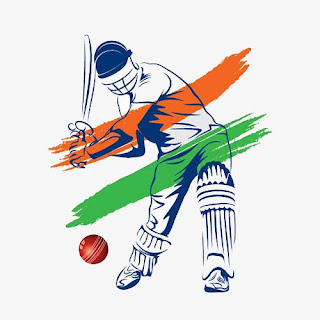Subject : AADUDAM ANDHRA : “Idi Andhari Aata" .
The Andhra Pradesh State has started a new Program called, Aadudam Andhra, a statewide sports tournament is initiated by the Government of Andhra Pradesh. Open to individuals aged 15 and above, this event encourages active living and fosters health awareness. It features competitive and non-competitive sports across 5 levels.
Competitive Games :
Competitive describes a situation where individuals or teams actively engage in a contest or activity with the goal of winning rewards, recognition, or prizes. They compete against others to achieve the best results and earn incentives or benefits.
Five major disciplines i.e., Cricket, Badminton, Volleyball, Kabaddi and Kho-Kho at all five levels for both men and women. All five games are considered to be competitive in nature which are played under Knockout category at each level.
CRICKET :
 |
| Cricket |
Match Format :
All matches follow a 10-overs-a-side format, ensuring quick and exciting gameplay.
Rule Adherence :
BCCI rules and regulations govern the matches, with some specific variations.
Spirit of the Game :
Players and officials must adhere to the sportsmanship and spirit of the game as outlined in the MCC Laws of Cricket 2007 - 2019 Edition.
Team Composition :
Captains select 11 players and up to 5 substitute fielders in writing, with changes requiring the opposing captain's approval.
Ball Type :
The matches are played with a red ball, influencing bowling and batting strategies.
Umpire Appointment :
Umpires are appointed by the association and are generally not changed during matches, except in exceptional circumstances or due to illness or injury.
Umpire Decisions :
Umpires' decisions are considered final and binding, with no provision for protests regarding their judgments.
Pre-Match Arrival :
Teams are required to report one hour before the scheduled match time, allowing for necessary preparations and formalities.
Players :
Each Captain shall nominate 11 players plus 5 Substitute fielders.
L1 & L2 Play :
Matches at the Grama/Ward Sachivalayam level and Mandal level will be contested using hard tennis balls, reflecting different levels of play and equipment standards.
L3 Play :
From Assembly Constituency Level onwards, cricket became a professional sport, played with specialised equipment and the use of a "Grace" cricket ball. This transition signifies a higher level of competition and adherence to professional standards and also mentions Shoe’s are mandatory from the Assembly Constituency level onwards.
Badminton :
 |
| Badminton |
The court is a rectangle with lines that are 40mm wide.
Length of the court: 13.40 metres.
Width of the court: 6.10 metres.
Shuttle :
The shuttle is made of normal, synthetic, or feathered material.
A feathered shuttle has 16 feathers fixed in the base.
Racket :
The racket's frame should not exceed 680mm in overall length and 230mm in overall width.
Toss :
A toss is conducted before play begins, and the winning side chooses whether to serve or receive first and which end of the court to start play
Scoring System :
A match consists of the best of three games.
A game is won by the side that first scores 21 points.
The side winning a rally adds a point.
If the score reaches 20, the side that gains a two-point lead first wins.
If the score reaches 29, the side scoring the 30th point wins the game.
The side winning a game serves first in the next game.
Change of Ends :
The ends change at the end of the first game, end of the second game, and in the third game when one side first scores 11 points.
Fault in Service :
A fault in service occurs when the shuttle is hit above waist level, when the racket shaft is not pointing towards the ground, when there is dragging of the leg, when there is a delay in service, or when there is a break in the service.
Lets :
The umpire calls a let when they are unable to make a decision due to the shuttle being unsighted, when both the server and receiver fault simultaneously, or when an unforced situation occurs.
VOLLY BALL :
Court Dimensions :
The playing court is a rectangular area measuring 18x9 meters, surrounded by a free zone at least 3 meters wide on all sides.
Net Height :
The net is placed vertically over the central line and set at a height of 2.43 meters for men and 2.24 meters for women.
Team Composition :
A volleyball team can have up to 12 players.
Match Format :
Volleyball matches consist of three sets, with two sets played to 25 points and a third set to 15 points. Each set must be won by a margin of two points. The first team to win two sets wins the match.
Timeouts :
Two timeouts of 30 seconds each are allowed per set for each team.
Substitutions :
Each team is allowed six substitutions per set.
Officials :
Volleyball matches are officiated by a 1st Referee, 2nd Referee, Scorer, and line referees.
Double Contact :
A player may not hit the ball twice in succession, except in the case of a block.
Body Contact :
It is legal to contact the ball with any part of a player's body.
Illegal Actions :
Catching, holding, or throwing the ball is considered illegal.
Simultaneous Contact :
If two or more players contact the ball at the same time, it counts as one play, and any of those players can make the next contact unless it's the team's fourth hit.
Blocking Serve :
A player cannot block or attack a serve from on or inside the 3-metre line.
Front Line Rotation :
After the serve, front-line players can switch positions at the net.
Five Players :
If a team has only five players, they will have a ghost position, causing them to lose the point when that position is serving.
Refereeing Team :
The referee/duty crew includes two referees, line judges, and a scorekeeper.
Basic Violations :
Violations result in a lost point and include stepping on or across the service line when serving, failing to serve the ball over the net successfully, illegal ball contact, touching the net during play (with exceptions), reaching over the net during blocking or attacking, crossing the centerline, serving out of order, and back-row players blocking and spiking when part of their body is above the top of the net (illegal block).


 pathankhan
pathankhan


0 comments:
Post a Comment